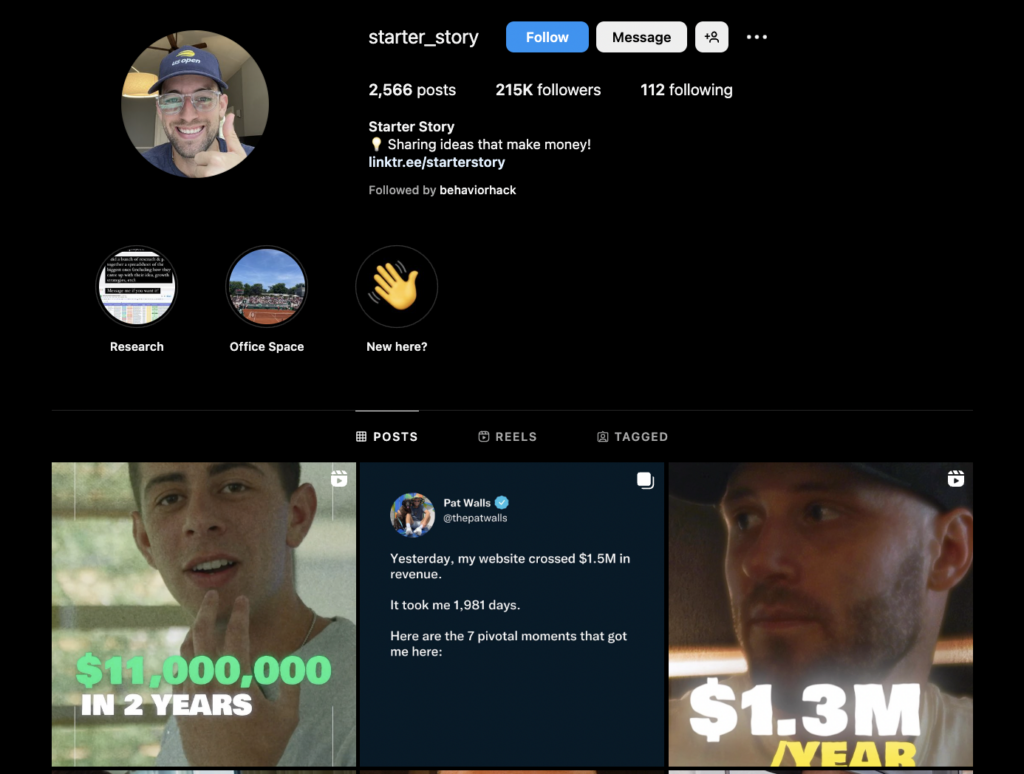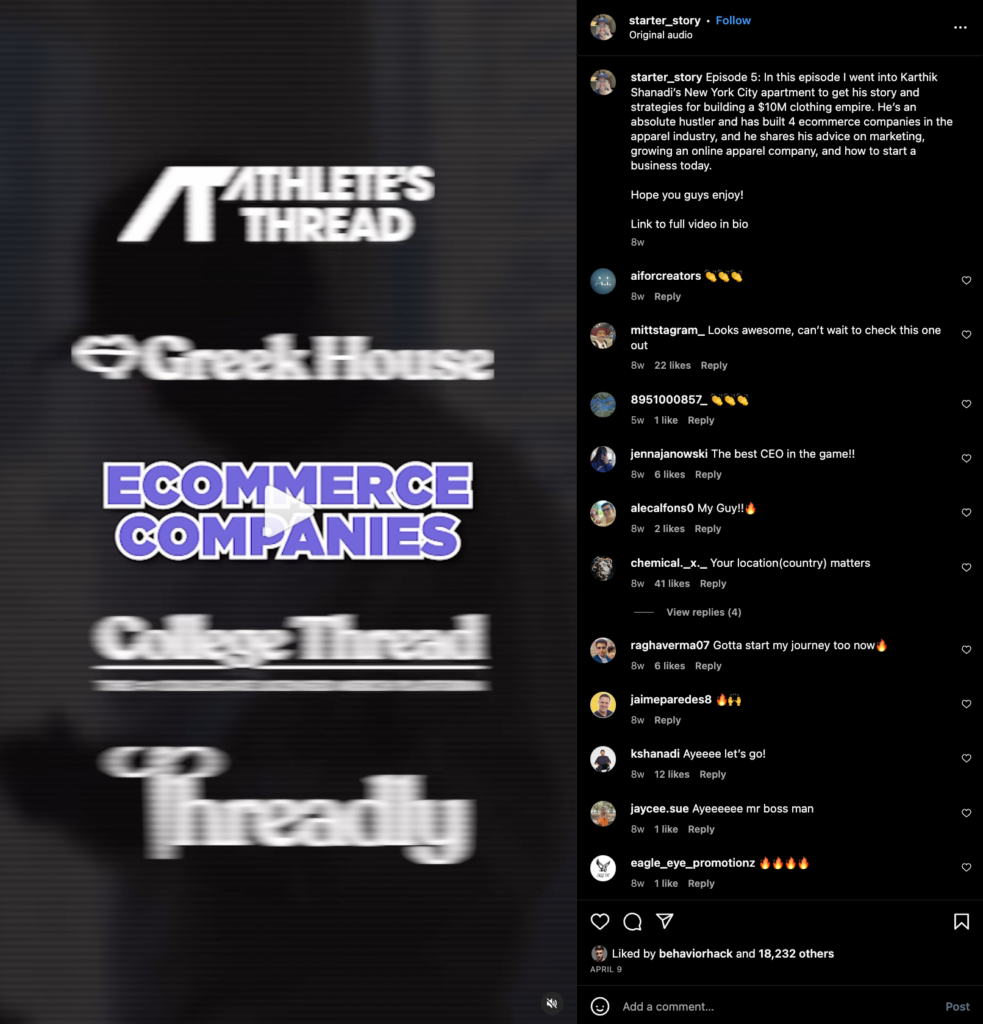12 June 2023 | Marketing
📈 Starter Story’s Viral IG Reels Formula
By
How Pat Walls generates 100K views per video on repeat…

Starter Story by Pat Walls is a media company built with the goal of helping people see what’s possible in online business.
Pat’s been going at this for ~7 years at this point, and the momentum around the brand + content is on fire in 2023.
He just launched his YouTube channel, which skyrocketed to 50K+ subscribers in just
And his email list is growing at a rate of ~2000 subs per day. Stupid.
Today I want to focus on 1 specific pillar of Starter Story’s content strategy that applies to you as a social media professional (or solo founder tryna grow on social):
Instagram Reels.
By the end of this piece, you’ll understand:
- Pat’s specific hook formula he’s used to generating 1M+ views on IG Reels
- The right way to use short form content to promote a YouTube channel
- 1 trend I am seeing in a lot of top accounts on social
Shall we?
How to write a high-performing hook 🪝
I noticed something as I was consuming Starter Story content.
Every video hook (since the launch of the new YouTube channel) followed a formula.
This is [name] + [monetary claim] + [unique method/framework]
A few examples:
Oliver Brocato (Tabs Chocolate)

“This guy made $11M in 2 years with just 1 product.
How? By capitalizing on one of the biggest marketing opportunities in years”

“This guy makes $1.3MM/year with a business model that’s gonna change the world”

“This is Justin. He built his online business to $1.7M/year working only 5 hours per day.
And the crazy part his… he runs it all by himself”

“This is Karthik. He turned $500 into $10M by building 4 different ecommerce companies.
What’s even crazier is that he built these companies with no funding and he had a full-time job”
What do you notice?
Same formula. On repeat.
Pat introduces the subject, makes a somewhat insane (but valid) monetary claim that would stop the scroll of someone who is interested in making money online, and then creates more curiosity by making another claim about how they did it.
The ‘how they did it’ piece usually includes some sort of unique or unusual framework — like Justin making 1.7M per year with zero employees.
The combination of the large, specific monetary figures and ‘unique method’ makes for a scroll-stopper hook.
Also worth noting, Pat spends an abnormal amount of time crafting and revising his content hooks.
On an interview with Danny Miranda, he revealing that be might rewrite a hook “20 times” to make sure he gets it right.
This is another common thread among the best content marketers I know. They spend a seemingly ridiculous amount of time sharpening the first 1-5 seconds of their content.
It seems insane to most people. But clearly, it works.
Spend more time on your hooks — and find a formula that you can run on repeat.
The right way to promote a YouTube video using social media channels 🎥
The days of clipping a segment of a YouTube video or podcast and tossing it straight onto Instagram (or any social platform) in hopes of it going viral are over.
The only exception to this I can think of is if the guest is so prominent (i.e. Elon Musk, LeBron James, etc) that the subject themselves can stop the scroll.
But for 90+ percent of brands ‘copy-pasting’ content from long-form to short form is a losing strategy.
A better approach?
Creating short-form content that is platform-native. A viewer should be able to finish watching your Instagram Reel and not feel like they got ‘tricked.’
They should feel like the promise in the hook was delivered upon.
That said, don’t be afraid of a good, old-fashioned CTA (call to action).
Pat melds platform-native content and promoting his YouTube channel seamlessly.
The Reels are created to be entertaining and engaging on Instagram, but he drops obvious CTAs in 2 spots of every video:
1) An end card in the last 1-2 seconds of the the Reel

2) In every Instagram caption

It’s direct. And that’s fine!
I think a lot of social media managers (myself included at times) are too cautious about giving direct calls to action. We think it comes across as ‘spammy’ or ‘salesy.’
My response?
Closed mouths don’t get fed.
If the goal is to increase YouTube subscribers → tell your community to head over to YouTube!
If the goal is to grow an email list → tell your community to sign up for your newsletter!
Will putting ‘link in bio’ in a caption hurt reach like every ‘IG growth coach’ (lmao) will tell you?
I don’t know. Maybe. But you can’t get so obsessed with every little algorithm nuance that may or may not be confirmed.
After enough times seeing your content hitting their feed on IG, they’ll get curious enough to check out the YouTube channel, podcast, newsletter… whatever that next step in your funnel is.
The playbook is simple. Make great content. Tell your community what to do next.
Run on repeat.
Why the best creators focus on evergreen content 🌲
The more I go down the rabbit hole of studying the best brand social media accounts and the best individual content creators, the more I see this pattern pop up:
They focus on (mostly) evergreen content.
Evergreen content is content that is always relevant. It’s not attached to a trend (like a viral audio or pop culture story). The content can hold its own 3 weeks, months, 3 years after it is published.
A few examples of this type of content I’ve been consuming other than Starter Story:
Represent’s ‘Behind the Brand’ series on YouTube.
This series is documenting George Heaton’s (Represent’s co-founder) process of building the brand, showing behind the scenes of certain campaigns, and his day-to-day life.
It’s not created with ‘YouTube optimization’ or virality in mind — it’s made with the intention to document the journey. And in turn, it attracts viewers that really resonate with the brand (the type of people that will eventually be customers).
David’s podcast summarizes and expands on biographies of some of the most notable high-performers in history (for example, recently listened to an episode on the biography of Tiger Woods).
This type of content doesn’t ‘expire.’
Pat’s content at Starter Story (on YouTube, on his site, on socials) follows a similar playbook.
Viewers can go back to Episode 1 of the YouTube series in a few months and still get value from it. I imagine this will hold true years from now.
Even on IG Reels, the focus of today’s case study:
if a new follower stumbles upon the Starter Story IG page 1 year from now, there is a whole library of binge-able content that is still relevant.
Evergeen content compounds.
This isn’t to say that trends are useless. They aren’t. Hell, I gave a whole presentation earlier this year on how to use trending content in your social media strategy.
But relying on trends becomes a problem.
Why?
- You’re not building true affinity with your community
- It’s exhausting to be trend-hunting all the time
‘Trending content’ best practices is a nuanced topic (nuance?! on the interent?!).
The best use of ‘trending content’ is to pour fuel on the fire.
And the best trends for your brand fit seamlessly into your content — like when I wrote this viral thread on an auto body shop that went ultra-viral on Twitter. Same content strategy I always use, but the topic just happened to be trending at the time.
See how this all works?
Pat is building something that viewers are able to binge — whether they find his content in 2 weeks or in 2 years.
TLDR
There are 3 key principals I want you to walk away from today’s breakdown with:
- Writing a compelling hook is a formula. Pat’s is:
This is [name] + [monetary claim] + [method/framework]
I’m not saying to rip this. I am saying to find your version of this — a content format or angle that your audience loves — and run with it. It will make your life insanely easier.
- Use short-form video to directly plug your YouTube channel (when applicable), just don’t be stupid about it.
Follow Pat’s lead and craft short-form that takes the best moments from the source material and packages it perfectly to perform well on-platform.
- Consider leaning more heavily on evergreen content.
Be ruthless with your criteria for which trends you hop on. These trends should be used with the intention to amplify what’s already working — not as the foundation of your strategy.
That’s all I’ve got today.